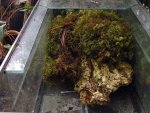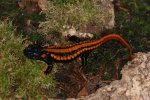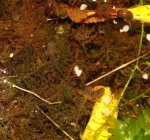The idea that the T.kweichowensis, T.verrucosus, and T.shanjing are a single variable species holds no water. It is quite easy to demonstrate separate species status, much harder to establish conspecificity, since it only takes one constant feature for the former, while ALL must be constant for the latter. Each is well-differentiated physically and genetically and shows little or no overlap in distribution or physical features. They do not share or commonly exchange genes. The many animals treated by the hobby as 'orange variants' of T.verrucosus are more than likely color phases of T.shanjing, though they might be one or more distinct species close to T.shanjing. I can see no reason to treat them as "T.verrucosus", as they possess the typical colors and patterns [albeit subdued in some] of topotypic T.shanjing and not those of topotypic T.verrucosus or of populations west or southwest of the type population. The original description of T.shanjing acknowledged a degree of variation which could represent two species or a degree of genetic introgression with T.verrucosus, but found the former to be quite consistant over a broad geographic range. That broad geographic consistancy indicates it to be specifically separate from adjoining populations of both T.kweichowensis and T.verrucosus, which are both also broadly consistant. There is no merging of features over their ranges, though each of these taxa contain variation which COULD indicate additional species. I continue to be puzzled as to why Nussbaum et al would simply allocate all non-Chinese animals to T.verrucosus, when there are fewer geographic barriers [and based on recent evidence, fewer physical differences] between the SE Asian populations and T.shanjing, than between the former and south Asian T.verrucosus.
On the matter of the new animals as variants of T.kweichowensis. This is possible, but I see it as unlikely. The original description recognized a fair amount of variation in this species, enough that the author allowed the possibility of more than one species being involved. Despite this, the species diagnosis included at least one trait which was consistant across a large range - fused red-orange lateral warts forming longitudinal stripes. In fact, for a long time [and still, from some exporters], all animals exported seemed to have those features. Perhaps a few had broken warts and stripes, which could admittedly be a possible rare variation within the species. More recently though, virtually all animals exported have had distinct warts and no lateral stripes, with rare exceptions which could be rare variants or true T.kweichowensis. This also coincides with noted range extensions into remote areas of Guangxi. If these were simply variants within the known range of a single species, then we should have seen BOTH forms commonly mixed, both now and even back when the species was first described. Instead, we see two forms, each presumably taken from a more or less single area of distribution, captured and exported in what is essentially complete isolation from one another. All of this is strongly indicative of geographically isolated and morphologically distinct species.
On the hybrid issue - highly doubtful. In addition to the points already noted regarding isolated and distinctive populations, animals of hybrid origin should show a mixture of features. We don't see that. We see animals which differ constantly from T.kweichowensis in lacking lateral fused warts, and also differ constantly from T.shanjing in possessing black limbs and head. Where are the rest of the "hybrids"? Where are the orange-head Guizhous? Where are the orange-leg Guizhous? Where are the striped shanjings? We see one 'variant' only, which argues against these being hybrids sharing genes for many differing features. I haven't mentioned black-legged shanjing, because these exist - in a single mountain range of Thailand, where there is no evidence of any other species or merging of features. Along with other differences, this too likely indicates a new species. Isolation or parapatry, distinctive and invariant traits = separate species.
Ensatinas are not a good comparison, as they represent what is thus far still a largely unique case in herps and a rarity among animals in general. They are decidedly NOT a single species, but the huge amount of genetic divergence among even nearby and physically similar animals makes it difficult to determine just how many species are involved and where one ends and another begins. A purely logical case can be made for naming a large number of perfectly valid species, but this raises the question of whether there is anything practical gain in naming a swarm of parapatric and largely indistinguishable species.
Eastern newts are also not a good comparison, as they have an essentially continuous range and differ only in trivial features of color which are to some degree scalar in nature. While there is considerable genetic variation and several main lineages which mostly coincide with the named subspecies, there is little to indicate that those lineages have any long isolation from one another. There is also evidence that in many locations the genetics do not coincide with the physical features and interbreeding is taking place freely.
Neurergus might be a better comparison - several species with small but constant differences in appearance, mostly separate and isolated geographic ranges, and sometimes differences in habitat type, but with the possibility that some of these may be complexes of parapatric species in addition to clearly distinguished allopatric species.
The description of T.notialis provides a good accounting of similar questions in subgenus Yaotriton, and also presents relevant information regarding distinguishing features in species of this genus. It also demonstrates the distinctiveness of the species of subgenus Tylototriton, though without an extensive range-wide comparison. It can be downloaded free from the lead author's website.



